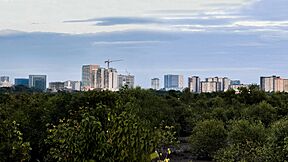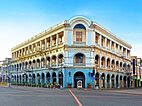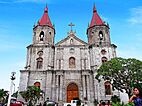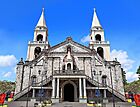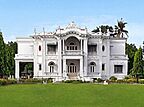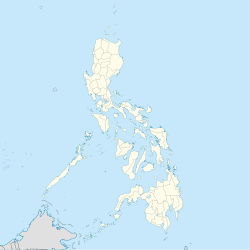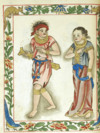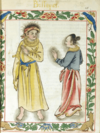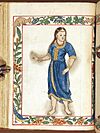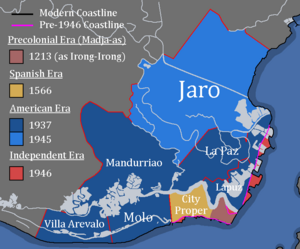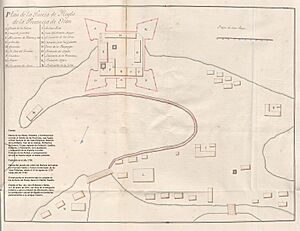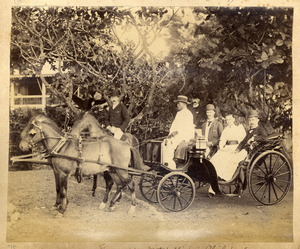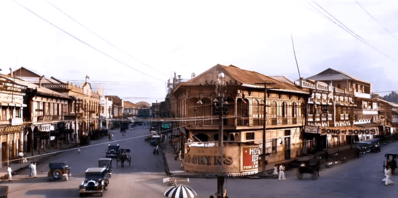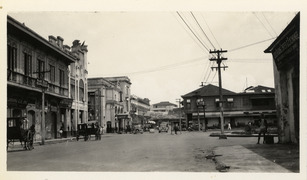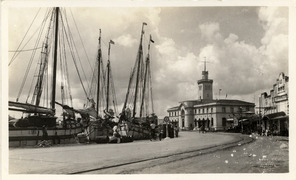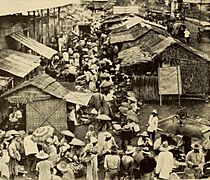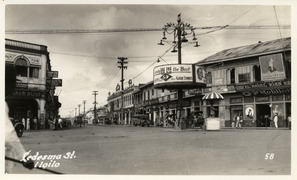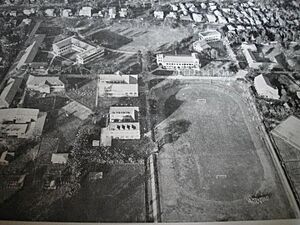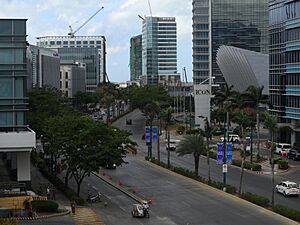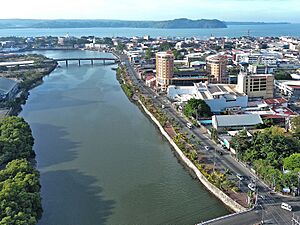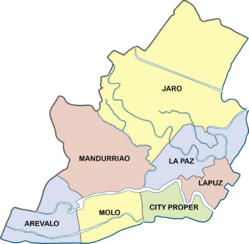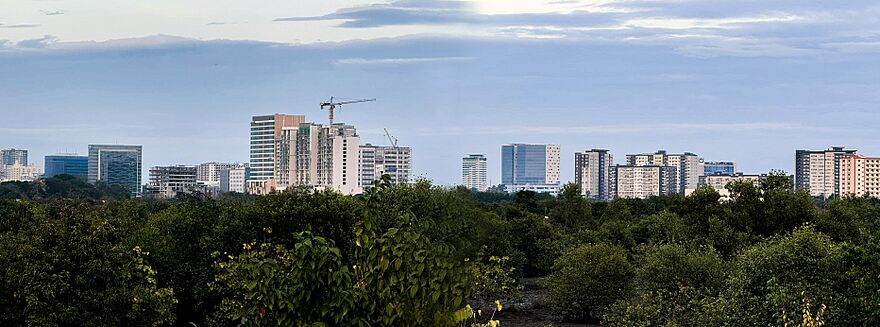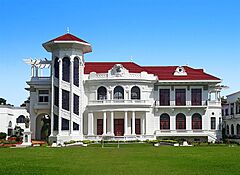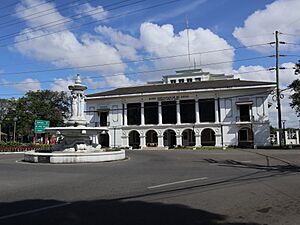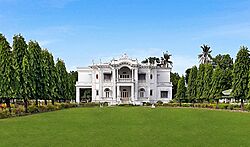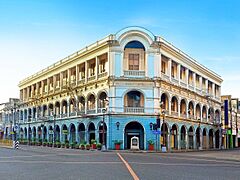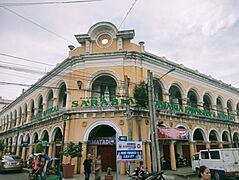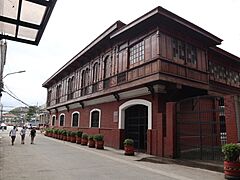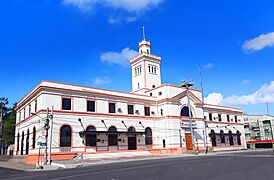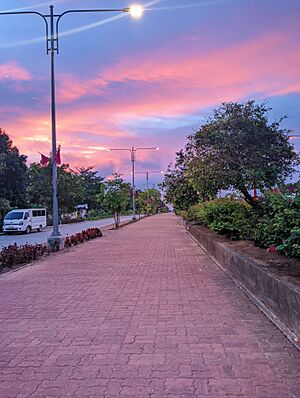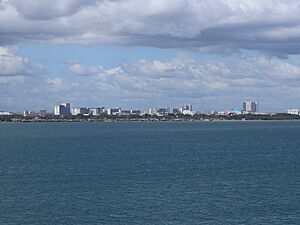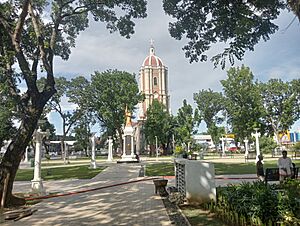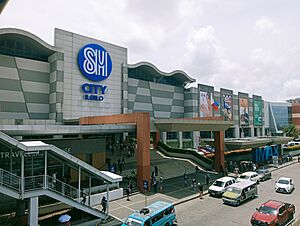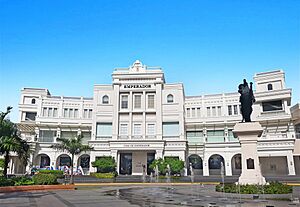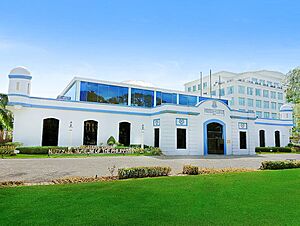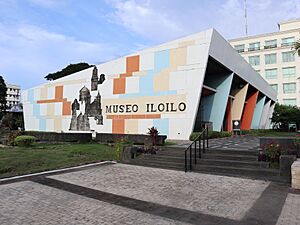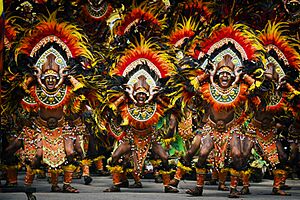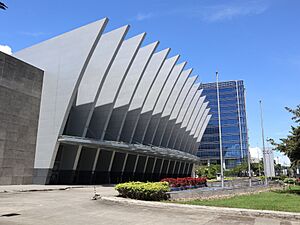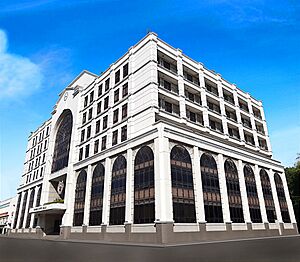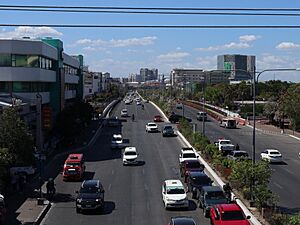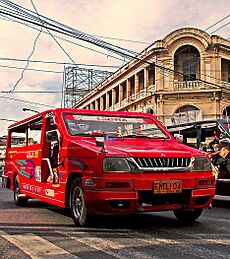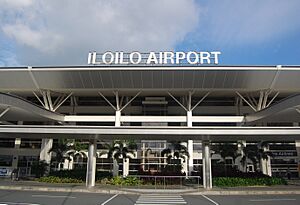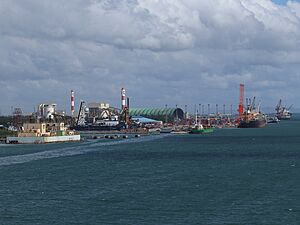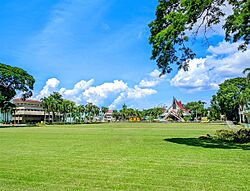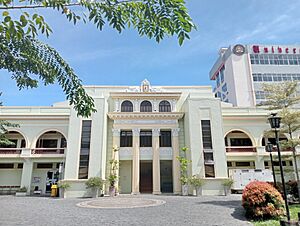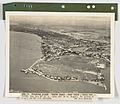Iloilo City facts for kids
Quick facts for kids
Iloilo City
|
|||||
|---|---|---|---|---|---|
|
Highly urbanized city
|
|||||
|
Skyline of Mandurriao district
Calle Real Heritage Zone
Molo Church
Jaro Belfry
Camiña Balay Nga Bato
Molo Mansion
Jaro Metropolitan Cathedral
Lopez Heritage House
|
|||||
|
|||||
| Nickname(s):
City of Love and others
|
|||||
| Motto(s):
La Muy Leal y Noble Ciudad de Iloílo (transl. The Most Loyal and Noble City of Iloilo)
|
|||||

Map of Western Visayas particularly Iloilo with Iloilo City highlighted
|
|||||
|
OpenStreetMap
|
|||||
| Country | Philippines | ||||
| Region | Western Visayas | ||||
| Province | Iloilo (geographically only) | ||||
| District | [[{{#property:P7938}} | — Lua error in Module:Wd at line 1804: attempt to index field 'wikibase' (a nil value).]] | ||||
| Founded | 1566 (Spanish settlement) | ||||
| Cityhood | October 5, 1889 | ||||
| Reincorporated | July 16, 1937 | ||||
| Highly urbanized city | December 22, 1979 | ||||
| Barangays | 180 (see Barangays and districts) | ||||
| City geographical districts |
List
Arevalo
City Proper Jaro La Paz Lapuz Mandurriao Molo |
||||
| Government
|
|||||
| • Type | Sangguniang Panlungsod | ||||
| Area | |||||
| • City | 78.34 km2 (30.25 sq mi) | ||||
| • Urban | 91 km2 (35 sq mi) | ||||
| • Metro | 1,105.53 km2 (426.85 sq mi) | ||||
| Elevation | 21 m (69 ft) | ||||
| Highest elevation | 175 m (574 ft) | ||||
| Lowest elevation | -1 m (−3.3 ft) | ||||
| Population
(2020 census)
|
|||||
| • City | 457,626 | ||||
| • Density | 5,841.5/km2 (15,129.5/sq mi) | ||||
| • Urban | 574,000 | ||||
| • Urban density | 6,310/km2 (16,340/sq mi) | ||||
| • Metro | 1,007,945 | ||||
| • Metro density | 911.730/km2 (2,361.370/sq mi) | ||||
| • Households | 104,313 | ||||
| Demonym(s) | Ilonggo (masculine) Ilongga (feminine) |
||||
| Economy | |||||
| • Gross domestic product (GDP) | ₱145.05 billion (2022) $2.563 billion (2022) |
||||
| • Income class | 1st city income class | ||||
| • Poverty incidence |
|
||||
| • HDI | |||||
| • Revenue | ₱ 4,143 million (2022) | ||||
| • Assets | ₱ 11,768 million (2022) | ||||
| • Expenditure | ₱ 3,294 million (2022) | ||||
| Service provider | |||||
| • Electricity | Monte Oro Resource Electric and Power Corporation (MORE) | ||||
| • Water | Metro Pacific Iloilo Water (MPIW) | ||||
| Time zone | UTC+8 (PST) | ||||
| ZIP code |
5000
|
||||
| PSGC |
[https://psa.gov.ph/classification/psgc/?q=psgc/barangays/{{#pro000®code={{&provcode=
|
||||
| IDD : area code | +63 (0)33 | ||||
| Native languages | Hiligaynon/Ilonggo | ||||
| Catholic diocese | Archdiocese of Jaro | ||||
| Patron saint | Nuestra Señora de la Purificación y la Candelaria (English: Our Lady of Purification and Candle) | ||||
| Website | iloilocity |
||||
Iloilo City, officially called the City of Iloilo, is a big city in the Western Visayas region of the Philippines. It is located on the southeastern coast of Panay island. In 2020, Iloilo City had about 457,626 people, making it the most populated city in Western Visayas. Its larger metropolitan area has over 1 million people.
The city is made up of seven main areas, which used to be separate towns. These are City Proper, Jaro, Molo, Mandurriao, La Paz, Arevalo, and Lapuz. Iloilo City is the largest city and capital of Iloilo province, but it has its own government. It is also the main center for trade, education, healthcare, and tourism in the Western Visayas region.
In 1566, the Spanish arrived and made Iloilo their second main base in the Philippines after Cebu. The city was given the special title 'La Muy Leal y Noble Ciudad' (The Most Loyal and Noble City) by the Spanish Queen. This was because the city stayed loyal to Spain during the Philippine Revolution. Iloilo City was the last capital of Spanish Empire in Asia before the Philippines became part of the United States in 1898.
Iloilo City is known as the first UNESCO Creative City of Gastronomy in the Philippines. This means it is famous for its delicious food like La Paz Batchoy and Pancit Molo. The city also has many old buildings and sites from the Spanish and American times, including the Calle Real Heritage Zone. It is also a pilgrim city and a center for devotion to the Candelaria.
Iloilo City is one of the fastest-growing cities in the Philippines. This growth started when the old airport in Mandurriao was redeveloped. The IT and BPO (Business Process Outsourcing) industries are growing fast here, making it a top place for these businesses outside Metro Manila.
Contents
- Etymology: What's in a Name?
- History: A Journey Through Time
- Geography: Where Iloilo City Is Located
- Cityscape: A Mix of Old and New
- Demographics: Who Lives in Iloilo City?
- Economy: How Iloilo City Thrives
- Culture: The Heart of Iloilo
- Government: How the City is Run
- Infrastructure: Getting Around and Staying Connected
- Healthcare: Staying Healthy
- Education: Learning and Growing
- Notable People
- Sister Cities: Friends Around the World
- Images for kids
- See also
Etymology: What's in a Name?
The name "Iloilo" comes from the older name "Irong-irong." This means "nose-like" and refers to the piece of land between two rivers, the Iloilo and Batiano rivers. This is where the old Fort San Pedro and the Spanish port were located.
History: A Journey Through Time
Early Beginnings
The first mention of Iloilo in writing is from the 1300s in Yuan Dynasty records. These records called Oton, a town west of Iloilo City, a busy trading post. Not much is known about the area before the Spanish arrived.
Local stories, like the epic Maragtas, tell how ten chiefs (datus) came from Borneo. They bought the lowlands of Panay from the Ati king. This story is said to be the inspiration for the Dinagyang Festival. However, historians now believe Maragtas is a story from the 20th century, not an old historical document. It mixes local folklore with new ideas.
Spanish Rule and Growth
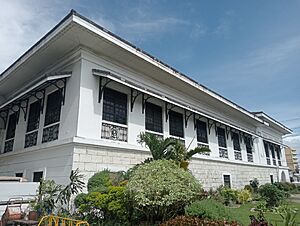
In 1565, Miguel López de Legazpi sent his grandson to explore the Visayas. They found a place in Panay and by 1566, a Spanish settlement was made. This was the second official Spanish settlement in the Philippines after Cebu. The people of Panay welcomed the Spanish as friends. They helped the Spanish fight against other groups.
Over time, Iloilo became a center for making textiles like sinamay and piña fabrics. These were sold in Manila and other countries. In 1855, the port opened to global trade. This led to a big boom in sugar production, making the city very rich. Many foreign consulates and banks opened here.
On October 5, 1889, Iloilo officially became a city. It was given the special title 'La Muy Leal y Noble Ciudad' (Most Loyal and Noble City) because of its loyalty to Spain. Iloilo was almost as important as Manila during this time. It was a key economic and military center.
During the Philippine Revolution, Iloilo stayed loyal to Spain at first. But after Spain lost the Spanish–American War in 1898, Iloilo briefly became the capital of the Spanish East Indies. On December 25, 1898, Spanish troops surrendered in Iloilo. This made Iloilo the last Spanish stronghold in Asia.
American Influence
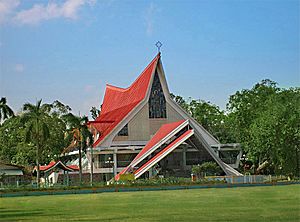
After the Spanish left, American forces arrived in 1900. Iloilo was changed from a city to a township. In 1903, several nearby towns like Jaro and Molo became part of Iloilo.
American Protestant missionaries also came to Iloilo. They started important schools and hospitals. These include Central Philippine University (1905), the Iloilo Mission Hospital (1901), and the Jaro Evangelical Church (1900). These institutions helped shape education and healthcare in the region.
The Americans also improved the city's roads and infrastructure. Iloilo regained its city status in 1936. More towns were added to the city in the following years.
- Gallery of Iloilo City during the American period
Japanese Occupation and Aftermath
In 1942, the Japanese invaded Panay. The economy stopped, and many areas were controlled by Japanese soldiers. During this time, Macario Peralta Jr. led a resistance movement that freed most of Panay from Japanese control.
After World War II, Iloilo's buildings were badly damaged. A huge fire in 1966 destroyed much of the downtown area. The sugar industry also declined. Many people left Iloilo to find better jobs elsewhere. This slowed down the city's growth for many years.
Slowly, Iloilo began to recover. New ports were built, attracting businesses and investments. Iloilo became a highly urbanized city in 1979. This new status meant its residents no longer voted for provincial officials.
Modern Times and Growth
In the early 2000s, Iloilo saw a big economic boost. The old Mandurriao Airport site was developed into a new business park. This brought many new businesses and real estate projects. These investments helped Iloilo become one of the fastest-growing economies in the Philippines.
In 2008, Lapuz became the seventh district of Iloilo City. This allowed it to have its own police and fire stations. In 2019, MORE Electric and Power Corporation took over the city's power distribution. They started modernizing the system, including putting cables underground.
In 2024, the Iloilo Commercial Port Complex was given to a company called ICTSI to manage. It was renamed the Visayas Container Terminal. This project aims to make the port more modern and improve trade.
Geography: Where Iloilo City Is Located
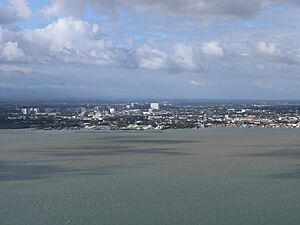
Iloilo City is on the southern coast of Panay island. It faces the Iloilo Strait and Guimaras island. This location creates a natural harbor, which is a safe place for ships. The city is surrounded by the towns of Oton, Pavia, and Leganes.
The city is mostly flat land, much of it built on reclaimed swampy areas. Several rivers flow through the city, including the Iloilo, Batiano, Jaro, and Dungon Creek. The Iloilo River separates some districts from the rest of the city. Iloilo City is about 337 kilometers from Manila. It covers a total land area of about 70.3 square kilometers.
Iloilo City has seven geographical districts: City Proper, Jaro, Molo, Mandurriao, La Paz, Arevalo, and Lapuz. Each district has its own town center with a plaza, church, and market. City Proper is the main business and political center.
Iloilo City is the center of the only official metropolitan area in Western Visayas. This area includes Iloilo City and nearby towns like Leganes, Pavia, and Oton. It also includes the island-province of Guimaras and its five towns.
Barangays and Districts: City Divisions
Iloilo City is divided into seven administrative districts. These districts are further split into 180 smaller areas called barangays.
|
|||||||||||||||||||||||||||||||||||||||||||||||||||||||||||||||
Climate: Iloilo's Weather
Iloilo City has a tropical climate with a wet season from June to November. The dry season lasts from December to May.
| Climate data for Iloilo, Philippines (1961–1990, extremes 1903–2012) | |||||||||||||
|---|---|---|---|---|---|---|---|---|---|---|---|---|---|
| Month | Jan | Feb | Mar | Apr | May | Jun | Jul | Aug | Sep | Oct | Nov | Dec | Year |
| Record high °C (°F) | 34.7 (94.5) |
35.5 (95.9) |
39.0 (102.2) |
37.5 (99.5) |
37.8 (100.0) |
37.5 (99.5) |
35.2 (95.4) |
34.8 (94.6) |
37.8 (100.0) |
35.4 (95.7) |
34.8 (94.6) |
34.5 (94.1) |
39.0 (102.2) |
| Mean daily maximum °C (°F) | 29.7 (85.5) |
30.2 (86.4) |
31.7 (89.1) |
33.1 (91.6) |
33.1 (91.6) |
31.6 (88.9) |
30.7 (87.3) |
30.4 (86.7) |
30.8 (87.4) |
31.1 (88.0) |
30.9 (87.6) |
30.2 (86.4) |
31.1 (88.0) |
| Daily mean °C (°F) | 26.1 (79.0) |
26.5 (79.7) |
27.6 (81.7) |
28.9 (84.0) |
29.1 (84.4) |
28.1 (82.6) |
27.6 (81.7) |
27.5 (81.5) |
27.6 (81.7) |
27.7 (81.9) |
27.5 (81.5) |
26.8 (80.2) |
27.6 (81.7) |
| Mean daily minimum °C (°F) | 22.7 (72.9) |
22.7 (72.9) |
23.5 (74.3) |
24.6 (76.3) |
25.1 (77.2) |
24.7 (76.5) |
24.4 (75.9) |
24.5 (76.1) |
24.4 (75.9) |
24.2 (75.6) |
24.0 (75.2) |
23.4 (74.1) |
24.0 (75.2) |
| Record low °C (°F) | 16.5 (61.7) |
16.7 (62.1) |
18.6 (65.5) |
20.0 (68.0) |
20.2 (68.4) |
21.0 (69.8) |
19.5 (67.1) |
20.0 (68.0) |
19.8 (67.6) |
19.2 (66.6) |
19.4 (66.9) |
18.3 (64.9) |
16.5 (61.7) |
| Average rainfall mm (inches) | 39.9 (1.57) |
19.1 (0.75) |
27.1 (1.07) |
47.7 (1.88) |
117.9 (4.64) |
255.2 (10.05) |
313.2 (12.33) |
363.7 (14.32) |
266.8 (10.50) |
264.1 (10.40) |
174.8 (6.88) |
64.2 (2.53) |
1,953.7 (76.92) |
| Average rainy days (≥ 0.1 mm) | 11 | 7 | 7 | 6 | 14 | 18 | 21 | 20 | 19 | 18 | 15 | 14 | 170 |
| Average relative humidity (%) | 82 | 80 | 75 | 73 | 77 | 82 | 85 | 85 | 85 | 84 | 84 | 83 | 81 |
| Source 1: Climate Charts | |||||||||||||
| Source 2: Deutscher Wetterdienst (rainy days), PAGASA (records) | |||||||||||||
Cityscape: A Mix of Old and New
Iloilo City has a long history as a trading center. Its buildings show a mix of Spanish and American styles, along with modern designs. The city is on a flat plain by the Iloilo Strait. The Iloilo and Batiano rivers flow through it. The city has many bike paths, trees, parks, and gardens.
Iloilo is made up of former towns, each with its own feel. Many civic centers have Spanish colonial designs with plazas, churches, and government buildings. New developments are mostly in Mandurriao. This helps protect the city's old buildings and environment.
Architecture: Buildings with Stories
Iloilo City is sometimes called the City of Mansions. Its buildings show a blend of Spanish and American influences. During the Spanish sugar boom, rich families built many grand mansions. Iloilo is now known for preserving its old buildings. It has the most restored heritage structures outside Metro Manila.
In 1930, architect Juan Arellano designed a city plan. It mixed old Spanish traditions with new American ideas. He designed the old Iloilo City Hall and the Aduana de Iloilo. These are great examples of American-era buildings.
Central Philippine University (CPU) is a good example of American influence. It is the largest university in the city. CPU was founded by American Baptists. Its campus has many old buildings in the classic American colonial style. These buildings are still used today.
The city has many different types of old buildings. In City Proper, Calle Real has many neoclassical and Art Deco buildings. In Arevalo, you can find bahay na bato style houses like Camiña Balay nga Bato.

In Jaro, there are grand Beaux-Arts mansions like the Lopez Heritage House. Jaro also has the Art Deco Jaro Municipal Hall and the Jaro Cathedral with its separate Jaro Belfry. In Molo, you can see the Gothic-style Molo Church and the restored Art Deco Molo Mansion.
The Casa Real de Iloilo is a government building in the bahay na bato style. The Arroyo Fountain is a beautiful landmark in front of it.
Iloilo has grown a lot recently. New modern buildings have been built, but the city still respects its heritage. The Iloilo Convention Center has a modern design inspired by local festivals. Many old plazas, homes, and government buildings have been restored.
- '''Some architectural examples of structures at Calle Real (Royal Street) Heritage Zone'''
Eco-Innovation: A Green City
Iloilo City is a great example of a city that cares about the environment. It has won awards like the Clean Air City Award. The city has banned plastic straws and requires wastewater treatment for the Iloilo River. It also has tree-planting programs and expanded mangrove forests.
The Iloilo River Esplanade is the longest park of its kind in the Philippines. It has many types of mangrove trees, which are important for marine life. Old plazas, parks, and the Iloilo Provincial Capitol complex have also been improved. All of the city's main plazas have been restored.
Iloilo is also becoming a smart city. It uses technology to make life better for its residents. There is free public Wi-Fi and electric public transport. The city has flood-prevention systems and air quality monitors. Taxis use navigation systems, and local areas use CCTV for safety. Iloilo is also very bike-friendly, with many bike lanes. It has won awards for being a top bike-friendly city.
Demographics: Who Lives in Iloilo City?
In 2020, Iloilo City had 456,626 people. It is the 25th most populated city in the Philippines. About 49% of the population are males and 51% are females.
Language: Speaking Ilonggo
Hiligaynon is the main language spoken in Iloilo City. English is used for business and education. Other local languages like Karay-a are spoken by a few people.
Hiligaynon is part of the Visayan language family. It is spoken across Panay, Guimaras, and Negros islands. Because Iloilo was a Spanish colony for 300 years, Hiligaynon has many Spanish words. Examples include puerta (door) and calle (street). People in Iloilo often call Hiligaynon "Ilonggo." "Ilonggo" also refers to the people and culture of Iloilo.
Religion: Faith in the City
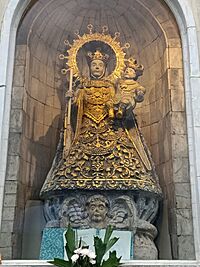
Iloilo City is an important religious center. Most residents are Catholic, due to 300 years of Spanish rule. There are also Protestant churches and other Christian groups.
Jaro is a hub for Christian institutions. The Archdiocese of Jaro is based there. The Jaro Metropolitan Cathedral is a National Shrine. It is a key place for devotion to Our Lady of Candles. This is the patroness of Western Visayas.
Protestantism came with the Americans. The Iloilo Mission Hospital was founded in 1901. It was the first American and Protestant hospital in the Philippines. Baptists founded the Jaro Evangelical Church in 1900. They also started Central Philippine University in 1905.
Other religious groups like Iglesia ni Cristo and The Church of Jesus Christ of Latter-day Saints are also present. There are also communities of Muslims, Sikhs, Taoists, and Buddhists.
Economy: How Iloilo City Thrives
Iloilo City has the second-largest economy in the Visayas, after Cebu City. It is growing very fast. It is the main economic center for Western Visayas. Key industries include trade, finance, technology, and tourism.
Historically, Iloilo's economy was strong during Spanish times. Sugar was its main export. The port opened to international trade in 1855. This made many families very rich. Iloilo became the second most important economic center after Manila. However, after World War II, the sugar industry declined.
|
||||
A new growth period started in the early 2000s. The Iloilo International Airport opened in 2007. This led to new developments like the Megaworld Corporation business park. Iloilo City also has one of the busiest ports in the country. It ranks high in bank savings and has a low crime rate. It is known as a very business-friendly city.
The service sector, like retail and banking, makes up most of the economy. The IT and BPO (Business Process Outsourcing) industries are also growing. Many IT companies are in Iloilo Business Park.
Tourism: Exploring Iloilo's Charms
Tourism is a big part of Iloilo's economy. The city is a gateway to Western Visayas. Festivals like Dinagyang and Paraw Regatta attract millions of visitors. The city's slogan is "Where the Past is Always Present." This is because old buildings stand next to modern ones.
Iloilo has many heritage sites, museums, and parks. It is also a food hub, famous for dishes like La Paz batchoy and pancit Molo. In 2018, Iloilo had over 1.2 million tourists. This number continued to grow in the following years.
Shopping and Retail: A Shopper's Paradise
Iloilo City has been a shopping center since colonial times. Hoskyn's Department Store, opened in 1877, was the first department store in the Philippines.
Today, Iloilo has many modern malls. These include SM City Iloilo, Robinsons Iloilo, and Festive Walk Iloilo. There are also malls in nearby towns.
Culture: The Heart of Iloilo
Iloilo City is rich in culture and tradition. It has many museums, heritage houses, and mansions. It is sometimes called the "museum city" and "city of mansions."
Museums: A Glimpse into the Past
Iloilo City has many museums. They cover ancient art, modern art, and history. You can see old pottery, gold, and artworks by famous Filipino artists. The Western Visayas Regional Museum is in the old Iloilo Provincial Jail.
Some notable museums are Museo Iloilo, the first government-built museum outside Manila. The Museum of Philippine Economic History tells the story of the Philippine economy. The Iloilo Museum of Contemporary Art (ILOMOCA) is the first museum in Visayas and Mindanao for modern art.
Other museums are found in universities, like the Henry Luce III Museum and Library. Heritage house museums, like Camiña Balay Nga Bato, show old ancestral homes. The Brandy Museum is the first and only museum in the Philippines dedicated to brandy.
Festivals: Celebrating with Joy
Iloilo's festivals are influenced by Spanish traditions. The city is sometimes called the "festival capital." The Dinagyang Festival is held every fourth Sunday of January. It honors the Santo Niño de Cebu and is one of the biggest festivals in the Philippines. The Kasadyahan Festival happens the Saturday before.
The Jaro Fiesta is on February 2. It is the largest Marian festival outside Luzon. It honors the Virgin of Candelaria. The Iloilo Chinese Lunar New Year celebrates the city's old Chinese community. The Festival of Lights and Music at Central Philippine University lights up its campus during Christmas. The Paraw Regatta in February is Asia's oldest traditional sailing event.
Arts: Creativity in the City
Iloilo's local government promotes the city as an "art capital." Public spaces are turned into canvases for murals and paintings. These artworks show the city's history and culture. A famous example is the 3D mural of Dinagyang warriors at Iloilo River Esplanade.
Entertainment: Fun in Iloilo
Teatro Malhabour, the first cinema outside Manila, opened in Iloilo in 1908. Other old cinemas like Cine Palace still operate today. Modern cinemas show many new films. The Film Development Council of the Philippines has a cinematheque theater in the city.
The annual Iloilo Film Festival shows many films during Dinagyang. The Iloilo Convention Center hosts concerts and performances. The Rose Memorial Auditorium at Central Philippine University is the largest theater in the region. Universities in Iloilo also have cultural groups that perform nationally and internationally.
Cuisine: A Food Lover's Dream

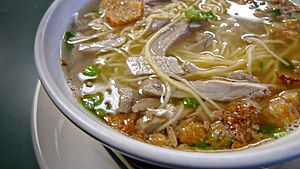
Iloilo City is a UNESCO Creative City of Gastronomy. It is known as the "Food Haven of the Philippines." Its food has both Eastern and Western influences. Spanish rule for over three centuries greatly shaped Ilonggo cuisine. Dishes like menudo and lechon are common. Rice is a main food, usually served with these dishes.
The city is famous for La Paz batchoy, pancit Molo, and kansi. Many restaurants offer international foods like Italian, Japanese, and Chinese. Iloilo City is also where Mang Inasal started. This is a popular fast-food chain serving chicken inasal.
Spanish influence also brought baking traditions. Old bakeries like Panaderia ni Paa and Deocampo still operate today. They are known for sweets like barquillos and biscocho.
Sports: Staying Active
The Iloilo City Sports Office manages sports activities. It organizes competitions among the city's seven districts. The Iloilo Sports Complex has a stadium, swimming pool, and courts for various sports. The Iloilo City Sports Center is also being developed.
Iloilo City has three professional sports teams. Kaya F.C.–Iloilo plays in the Philippines Football League. D'Navigators Iloilo competes in Spikers' Turf. Kaya Women's Futbol plays in the PFF Women's League.
Media: News and Entertainment
Iloilo City has English newspapers like Panay News and The Daily Guardian. Hublas is the only Hiligaynon newspaper. Cream Magazine is a lifestyle publication. Bombo Radyo Philippines, a large radio network, started in Iloilo City in 1966.
Television stations like ABS-CBN and GMA have local channels. Other stations like PTV and TV5 Iloilo also broadcast here.
Government: How the City is Run
Iloilo City is the regional capital of Western Visayas. It is also the provincial capital of Iloilo Province. It is a highly urbanized city, which means it runs independently from the province.
The city is led by the Mayor of Iloilo City. A vice mayor helps the mayor. The city also has a congressman in the House of Representatives. The Iloilo City Council has 15 members. They are elected during general elections. The city is divided into 180 barangays, each with a barangay captain.
| City Government of Iloilo | |||
|---|---|---|---|
| Mayor | |||
| Raisa Maria Lourdes Treñas-Chu (NUP) | |||
| Vice Mayor | |||
| Lady Julie Grace L. Baronda (Lakas) | |||
| Sangguniang Panglungsod Members | |||
| Sedfrey L. Cabaluna (NUP) | Mandrie T. Malabor (NUP) | ||
| Jose Maria Miguel S. Treñas (NUP) | Johnny Y. Young (PFP) | ||
| Rex Marcus B. Sarabia (NUP) | Romel D. Duron (PFP) | ||
| Alan A. Zaldivar (PFP) | Rudolph Jeffrey O. Ganzon (NUP) | ||
| Lyndon V. Acap (NUP) | Sheen Marie S. Mabilog (Lakas) | ||
| Jose Maria B. Dela Llana (PFP) | Frances Graces V. Parcon-Torres (PFP) | ||
| ABC Presidents | |||
| Jaro – Rodel Mamon | Mandurriao – Ariel Mirar | ||
| La Paz – Ruby Ann Geanga | Molo – Lee Quimsing | ||
| City Proper – Madonna Martin | Lapuz – Arniel Asturias | ||
| Arevalo – Rico Francis Acap | |||
| SK Federation President | |||
| Jelma Crystel Implica | |||
Infrastructure: Getting Around and Staying Connected
Transportation: Moving Through the City
Land Travel
Major roads in Iloilo City include Benigno S. Aquino Jr. Avenue and McArthur Drive. Benigno S. Aquino Jr. Avenue is an eight-lane road with a bike lane. It connects Iloilo City to nearby towns and the airport.
You can travel around the city using jeepneys, taxis, and tricycles. Jeepneys follow fixed routes, while tricycles cover smaller streets. Buses and vans connect Iloilo City to other parts of Panay island. You can also take RO-RO ferries to other islands.
Iloilo City was one of the first to use modern public utility jeepneys (PUJs). There are six main transport terminals in the city. These terminals connect Iloilo City to different parts of Iloilo province and Panay.
Iloilo City is known as the "Bicycling Capital of the Philippines." It has almost 100 kilometers of bike lanes. The longest one is along Diversion Road. The Iloilo River Esplanade also has dedicated bike lanes.
Air Travel
Iloilo International Airport is the main airport for Iloilo City. It is the fifth-busiest airport in the Philippines. The airport is about 19 kilometers northwest of the city. It opened in 2007, replacing the old Iloilo Airport. You can get to the airport by taxi, shuttle, or bus.
| Iloilo International Airport Routes |
| International |
| Bangkok-Don Mueang, Hong Kong, Singapore |
| Domestic |
| Cagayan de Oro, Cebu, Clark, Davao, Dumaguete, General Santos, Legazpi, Manila, Puerto Princesa, Tacloban, Tagbilaran, Zamboanga |
Sea Travel
The Port of Iloilo is a major seaport in the central Philippines. It has several facilities, including the Iloilo Commercial Port Complex (ICPC). In 2024, ICTSI took over management of the ICPC and renamed it the Visayas Container Terminal (VCT). This aims to modernize the port.
The Iloilo Domestic Port Complex handles ferries to other islands. Muelle Loney, opened in 1855, now serves smaller ships and fast ferries. The Port of Iloilo is one of the busiest in the country for ships, cargo, and passengers.
Small boats connect the ferry port in Parola to Guimaras. The Iloilo Fish Port Complex is the main fish trading hub in the Visayas. It supplies fish locally and internationally.
Rail Travel
The railway system on Panay island used to run from Muelle Loney Wharf to Roxas City. It operated for almost 80 years but stopped in the 1980s. There are plans to bring the railway system back. This would connect major cities in Panay, including Iloilo City and Roxas City.
Utilities: Power and Water
Iloilo City gets its power from two large plants in Ingore, La Paz. The Panay Power Corporation runs a diesel plant. The Panay Energy Development Corporation (PEDC) runs a coal power plant. PEDC plans to add another coal plant to increase power supply for Panay and Guimaras islands.
For a long time, the Panay Electric Company (PECO) handled power distribution. But in 2019, MORE Electric and Power Corporation (MORE Power) took over. They have introduced modern power services, including underground cabling.
Metro Pacific Iloilo Water (MPIW) is the city’s only water supplier. It works to improve clean water supply for Iloilo City and the whole metropolitan area. A new desalination plant is being built to provide more water. The city is also building a new waste management facility.
Healthcare: Staying Healthy
The Iloilo City Health Office works with the Department of Health (DOH). They plan and carry out healthcare programs for the city. This includes free immunizations for children against common diseases. The city has health centers in its barangays.
Three government hospitals serve the city. These are West Visayas State University Medical Center (WVSUMC), Western Visayas Medical Center (WVMC), and the new Iloilo City Hospital (ICH). WVSUMC helps patients who cannot afford medical care. WVMC is the largest public hospital in the region. ICH is being built to help more residents.
There are also private and church-affiliated hospitals. CPU–Iloilo Mission Hospital (IMH) was founded in 1901. It was the first Protestant and American hospital in the Philippines. St. Paul’s Hospital Iloilo (SPH Iloilo) was established in 1911. Both are important heritage healthcare institutions.
Other private hospitals include The Medical City-Iloilo and Healthway QualiMed Hospital Iloilo. These hospitals have modern technology.
Education: Learning and Growing
Iloilo City is the main education center in the Western Visayas region. It has eight higher education institutions.
- Central Philippine University (1905) was founded by American Baptists. It was the first Baptist and second American and Protestant university in Asia. It is known for its nursing school, which was the first in the Philippines.
- The University of San Agustin (1904) was founded by Spanish Augustinians. It was the first university in Western Visayas.
- St. Paul University Iloilo (1946) was established by American Catholics.
- University of Iloilo (1947) was founded by the Lopez family.
- John B. Lacson Foundation Maritime University (1948) is the first maritime university in the Philippines.
Three government universities are in Iloilo City:
- University of the Philippines Visayas (1947) has a campus in Iloilo City.
- West Visayas State University (1902) was started by American teachers.
- Iloilo Science and Technology University (1905) was founded as a trade school.
A new campus of National University is being built. The Ateneo Graduate School of Business also has a campus here.
Iloilo City Community College (ICCC) is run by the city government. There are also many private colleges and schools. These include Iloilo Doctors' College, Ateneo de Iloilo, and Colegio de San Jose. The Department of Education oversees many private and public schools in the city.
Notable People
Sister Cities: Friends Around the World
Iloilo City has special connections with other cities.
International Sister Cities
Domestic Sister Cities
- General Santos, South Cotabato, 1980
- South Cotabato, 1980
- Quezon City, Metro Manila, 1994
- Marikina City, Metro Manila, 1994
- Mandaue, Cebu, 2007
- Bacolod, Negros Occidental, 2010
- Rosario, Batangas, 2011
- San Juan, Metro Manila, 2013
- Tacurong, Sultan Kudarat, 2014
- Koronadal, South Cotabato, 2014
Friendship Cities
Iloilo City also has friendly relations with:
 Seattle, United States, 1980
Seattle, United States, 1980 Icheon, South Korea, 1995
Icheon, South Korea, 1995 Brisbane, Australia, 2000
Brisbane, Australia, 2000 Tongyeong, South Korea, 2003
Tongyeong, South Korea, 2003 Hsinchu, Taiwan, 2004
Hsinchu, Taiwan, 2004 Bilbao, Spain, 2007
Bilbao, Spain, 2007 Kaoshiung, Taiwan, 2007
Kaoshiung, Taiwan, 2007 Daly City, United States, 2011
Daly City, United States, 2011- Makati, Metro Manila
- Puerto Princesa, Palawan
- Taguig City, Metro Manila
- Tagum, Davao del Norte
Images for kids
See also
 In Spanish: Iloílo para niños
In Spanish: Iloílo para niños


